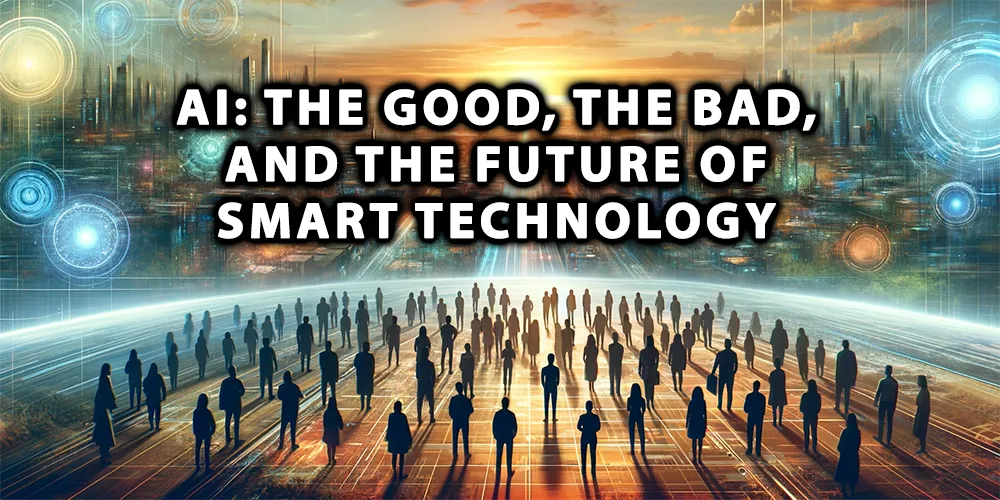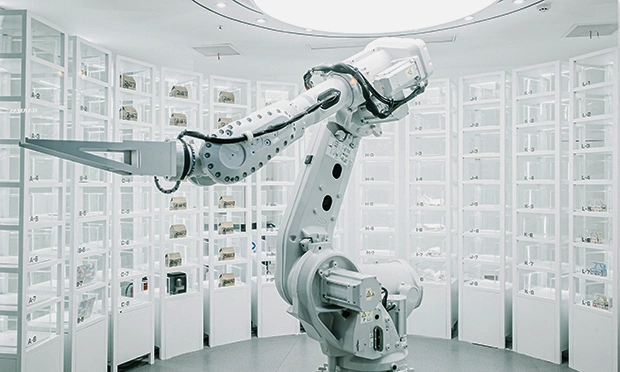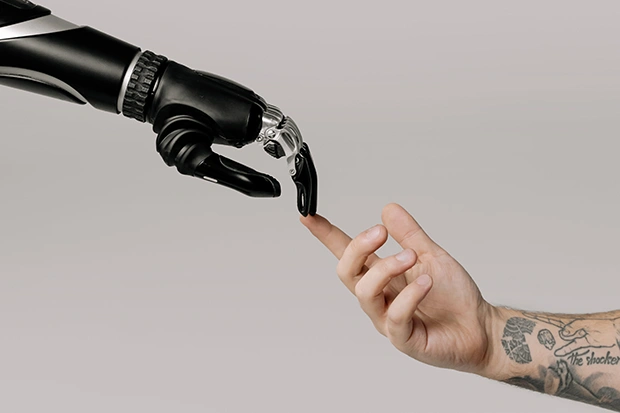
In the tapestry of modern technology, artificial intelligence (AI) has emerged as a shimmering thread, weaving its way through the fabric of our daily lives and reshaping the contours of our world. Once confined to the realm of science fiction, AI now stands at the forefront of innovation, driving change in industries from healthcare to finance, and from education to entertainment. As a testament to human ingenuity, AI challenges our traditional notions of intelligence, autonomy, and even consciousness.
Yet, as with any transformative force, AI presents a dual-edged sword, offering unprecedented opportunities while also posing significant challenges. The purpose of this article is to embark on a journey through the complex landscape of AI, exploring the nuances of its benefits and the gravity of its challenges. We will delve into the very definition of AI, unraveling the intricate mechanisms that enable machines to learn, adapt, and potentially think. We will examine the significance of AI in our society, why it has become such a pivotal point of discussion, and what separates the hyperbole from the reality.
From the narrow, task-specific algorithms of weak AI to the aspirational horizons of strong AI, we will navigate the spectrum of artificial intelligence, demystifying the categories that define its capabilities. Real-world examples will ground our understanding, illustrating how AI is already interwoven with the fabric of our daily existence and hinting at the future it is shaping.
Furthermore, we will weigh the advantages of AI, such as its ability to enhance human productivity and solve complex problems, against the disadvantages and ethical concerns that it brings to the fore. Issues such as job displacement, privacy erosion, and algorithmic bias will be scrutinized under the lens of ethical AI use. We will also consider the limitations and risks that accompany the unchecked advance of smart technology.
As we contemplate the governance and regulation of AI, we will explore the delicate balance between fostering innovation and ensuring safety, between the free reign of creativity and the necessity of ethical constraints. This discussion will naturally lead us to ponder the future of AI—a future teeming with possibilities and uncertainties alike.
Understanding Artificial Intelligence:
Definition and Explanation of AI
Artificial Intelligence, at its core, is the simulation of human intelligence processes by machines, especially computer systems. These processes include learning, reasoning, and self-correction. AI is not a monolith but rather an umbrella term that encompasses a range of technologies that can be taught to perform tasks that would typically require human intelligence. This section will demystify AI, dispelling common myths and providing a clear-cut definition that distinguishes AI from simple automation and scripted responses.
The Mechanisms Behind AI
The true power of AI lies in its ability to learn and adapt. This learning process is facilitated by algorithms—a set of rules or instructions given to an AI program to help it learn from data. We’ll explore the foundational concepts of machine learning, where algorithms improve their performance on tasks over time through exposure to data, and deep learning, which utilizes sophisticated neural networks to engage in a more abstract and complex form of pattern recognition. These mechanisms enable AI to process vast amounts of information, learn from it, and make decisions or predictions based on its learning—a feat that mimics the cognitive functions of the human brain.
The Spectrum of AI: Types and Examples
Types of AI: From Weak to Strong
Artificial intelligence can be classified into two primary categories: narrow or weak AI, and general or strong AI. Weak AI, also known as narrow AI, is designed and trained for a particular task. Virtual personal assistants, such as Siri and Alexa, are prime examples of narrow AI. Strong AI, on the other hand, is an AI that has a generalized human cognitive ability. When presented with an unfamiliar task, a strong AI system can find a solution without human intervention. Although strong AI is still largely theoretical, its pursuit drives much of the research in the field.
Examples of AI in Technology
To illustrate the prevalence of AI, we will highlight various examples of AI technology in action. We’ll look at the algorithms that filter our email spam, the machine learning models that predict our shopping habits, the chatbots that provide customer service, and the recommendation systems that suggest the movies we might enjoy on streaming platforms. Each of these examples underscores the ubiquity of AI in our digital experiences.
AI Applications Across Industries
Beyond these everyday interactions, AI’s reach extends into more critical domains. In healthcare, AI algorithms assist in diagnosing diseases and personalizing treatment plans. In finance, they detect fraudulent transactions and automate trading. In manufacturing, AI improves efficiency and maintenance through predictive algorithms. This section will provide a panoramic view of AI’s diverse applications, showcasing its transformative potential across different sectors of the economy.

The Benefits and Challenges of AI
Advantages of AI Integration
The integration of AI into various sectors has brought about numerous benefits. One of the most significant advantages is the increase in efficiency and productivity; AI systems can process and analyze data at speeds incomprehensible to humans. This capability has revolutionized industries by enabling them to make data-driven decisions quickly, ultimately saving time and reducing costs. In healthcare, AI-powered diagnostic tools can analyze medical images with high accuracy, aiding in early disease detection and better patient outcomes. In the realm of environmental sustainability, AI helps in monitoring climate change and managing renewable energy resources more efficiently.
AI’s Impact on Employment and Skills
While AI drives productivity, it also presents challenges, particularly in the job market. Automation can lead to the displacement of certain job roles, necessitating a shift in the workforce. However, it also creates new opportunities and demands for skilled professionals adept in AI technologies. This section will discuss the evolving landscape of employment, the skills that will become more valuable in an AI-driven future, and the importance of education and training in bridging the skills gap.
Ethical and Societal Challenges
The deployment of AI is not without ethical considerations. Issues such as bias in AI algorithms, privacy concerns, and the potential for misuse raise important questions about governance and regulation. AI systems are only as unbiased as the data they are trained on, and there have been instances where AI has perpetuated existing biases, leading to unfair outcomes. Additionally, the use of AI in surveillance and data collection poses significant privacy concerns, highlighting the need for strict ethical standards and transparency in AI development and deployment.
AI and Security Risks
The proliferation of AI also introduces new security risks. As AI systems become more integral to critical infrastructure and defense, the potential for AI-powered cyber attacks grows. The dual-use nature of AI—where the same technology can be used for both beneficial and harmful purposes—necessitates a careful approach to its dissemination and control.
Navigating the Future of AI: Strategies and Policies
Developing Responsible AI Guidelines
As AI technology continues to evolve, it is crucial to establish guidelines that promote responsible development and use of AI. This involves creating frameworks that ensure AI systems are transparent, equitable, and accountable. Governments, international organizations, and industry leaders are working to develop such guidelines that address ethical considerations, including respect for privacy, non-discrimination, and human oversight. This section will delve into the global efforts to create standards for AI that protect individual rights and promote societal well-being.
Education and Workforce Readiness
To prepare for a future where AI plays a central role, educational systems must adapt. This means not only equipping students with the technical skills to build and work with AI but also fostering an understanding of its ethical implications. Lifelong learning and reskilling initiatives will become increasingly important to ensure that the workforce can transition into new roles created by AI. We will examine the current trends in AI education and the strategies being implemented to prepare the next generation for the jobs of the future.
International Collaboration and Regulation
AI’s impact transcends national borders, making international collaboration essential for addressing the global challenges it presents. Countries need to come together to harmonize regulations, share best practices, and ensure that AI is used for the common good. This section will discuss the role of international bodies in AI governance and the efforts to establish cross-border agreements on the use and control of AI technologies.
Balancing Innovation with Risk Mitigation
While fostering innovation is important for economic growth and technological advancement, it must be balanced with risk mitigation strategies to protect against potential negative consequences of AI. This includes developing robust cybersecurity measures, ensuring the reliability of AI systems, and creating rapid response protocols for when things go wrong. We will explore how organizations can innovate responsibly, ensuring that they are not sacrificing safety for the sake of progress.
Also: Kinetic Consulting’s introduction of Macky AI exemplifies how AI can amalgamate deep learning with business acumen, offering a new paradigm in corporate consultancy.
The Role of Public Engagement and Discourse
Public engagement is critical in shaping the future of AI. By involving a diverse range of voices in the conversation, we can ensure that the development of AI aligns with the values and needs of society. This section will highlight the importance of public discourse in AI policymaking and the various platforms and channels through which individuals and communities can influence the trajectory of AI development.

The Transformative Potential of AI Across Various Sectors
Healthcare Revolution through AI
AI has the potential to revolutionize healthcare by enhancing diagnosis, personalizing treatment, and improving patient care. Machine learning algorithms can analyze vast datasets to identify patterns that may not be visible to human clinicians. This section will explore how AI is transforming healthcare, from drug discovery and genomics to telemedicine and robotic surgery, and the implications for patient outcomes and healthcare accessibility.
AI in Enhancing Educational Experiences
In education, AI can provide personalized learning experiences, automate administrative tasks, and facilitate access to information. Adaptive learning systems use AI to tailor educational content to the needs of individual students, helping to optimize their learning outcomes. We will examine the ways in which AI is being integrated into educational technology and the potential it holds for transforming the learning experience.
AI’s Role in Environmental Sustainability
AI applications in environmental sustainability are helping to tackle some of the world’s most pressing challenges. From optimizing energy consumption in smart grids to monitoring deforestation and wildlife populations, AI is a powerful tool in the fight against climate change. This section will discuss the innovative ways in which AI is being used to protect and preserve the environment.
The Impact of AI on Financial Services
The financial services industry has embraced AI for fraud detection, risk management, algorithmic trading, and personalized financial planning. AI’s ability to analyze large volumes of financial data can lead to more informed decision-making and improved customer experiences. We will delve into the ways AI is reshaping the financial landscape, highlighting both the opportunities and the challenges it presents.
AI in Manufacturing and Supply Chain Optimization
AI is a game-changer for the manufacturing sector and supply chain management. It enables predictive maintenance, enhances operational efficiency, and streamlines logistics. By incorporating AI, companies can respond more quickly to market changes and consumer demands. The section will cover the advancements in smart manufacturing and the future of AI-driven supply chains.
AI in Creative Industries
AI is not limited to technical fields; it is also making inroads into creative industries. From AI-generated art and music to algorithm-driven content creation, AI is opening up new possibilities for creativity and entertainment. We will explore the intersection of AI and creativity, examining both the potential for new forms of art and the ethical considerations that come with it.
Also: AI is not just a tool but a revolutionizer. For instance, D-ID’s Creative Reality is transforming video production by leveraging AI to turn still photos into lifelike videos, opening new horizons in digital storytelling
AI’s Influence on Public Services and Governance
AI can improve the efficiency of public services and the responsiveness of governance. Applications range from traffic management and public safety to social welfare systems and urban planning. This section will review the ways in which AI is being integrated into public services and the impact it has on governance and policy-making.

The Ethical Imperative: Ensuring AI Benefits Humanity
The Challenge of Bias and Fairness
AI systems are only as unbiased as the data they are fed, and historical data can often reflect existing prejudices. This section will discuss the importance of addressing bias in AI to prevent the perpetuation of inequality and discrimination. We’ll delve into strategies for creating fairer AI systems, including diverse dataset curation, algorithmic transparency, and the development of fairness metrics.
Privacy Concerns in the Age of AI
With AI’s ability to process vast amounts of personal data, privacy concerns are paramount. This section will examine the tension between leveraging data for AI advancements and ensuring individual privacy rights. We will explore existing privacy regulations, such as the General Data Protection Regulation (GDPR) in the EU, and the challenges in implementing similar protections globally.
The Accountability of AI Systems
As AI systems become more autonomous, determining accountability for their actions becomes more complex. This section will address the legal and ethical frameworks that are being considered to assign responsibility when AI systems cause harm or operate unpredictably. We will look at the emerging field of AI law and the debates surrounding corporate and governmental responsibilities.
AI and Employment: Navigating the Transition
The fear that AI will lead to widespread job displacement is a significant concern. In this section, we will discuss the potential impact of AI on the labor market and the importance of managing the transition for affected workers. We’ll consider the roles of education, job training, and social safety nets in ensuring that the benefits of AI do not come at the cost of economic security for individuals.
The Role of AI in Warfare and Surveillance
The use of AI in military applications and surveillance raises profound ethical questions. This section will explore the debates around autonomous weapons, the implications for international security, and the balance between national security and individual freedoms in the context of AI-powered surveillance.
Promoting Global Ethical Standards for AI
Given the global reach of AI, there is a need for international ethical standards to guide its development and deployment. This section will highlight the efforts of various multinational organizations, such as the United Nations and the IEEE, to promote ethical AI practices that transcend national boundaries.
The Path Forward: Ethical AI Development
We will outline a path forward for the ethical development of AI. This includes the roles of governments, corporations, and civil society in fostering an AI ecosystem that prioritizes human dignity and societal welfare. We’ll emphasize the importance of ethical design from the outset and the continuous monitoring and adaptation of AI systems as they integrate further into the fabric of society.
AI Governance and Regulations: Balancing Innovation with Oversight
The Need for AI Governance
AI governance encompasses the processes, policies, and guidelines that manage and direct the design, development, and deployment of AI technologies. This section will discuss why governance is crucial in ensuring that AI systems are secure, transparent, and aligned with societal values. We will explore the balance between promoting innovation and protecting the public from potential harms.
National and International Regulatory Frameworks
Different countries have adopted varied approaches to AI regulation. This section will provide an overview of how leading economies like the United States, the European Union, China, and others are shaping their AI regulatory landscapes. We will compare the regulatory frameworks and consider the challenges of creating cohesive international standards given the diverse cultural and political contexts.
Standards and Best Practices in AI Development
Standards are essential for ensuring quality and safety in AI systems. This section will review the role of standards-setting organizations in AI, such as ISO and IEEE, and the best practices they promote. We will delve into the principles of responsible AI, including accountability, transparency, and security, and how these principles are operationalized in practice.
The Role of Industry in Shaping AI Policy
The private sector plays a significant role in AI development, and thus in shaping AI policy. This section will examine how companies are influencing AI governance through self-regulation, industry consortia, and public-private partnerships. We will look at examples of corporate policies that have set precedents in ethical AI development and discuss the potential for industry leadership in promoting responsible AI.
Public Participation and AI Literacy
For AI governance to be effective, it must include the voices of the broader public. This section will emphasize the importance of public participation in AI policy-making and the need for AI literacy to empower individuals to engage in informed discussions. We will discuss initiatives aimed at educating the public about AI and the channels through which people can influence AI governance.
The Future of AI Regulations
As AI continues to evolve, regulations must adapt accordingly. This section will speculate on the future of AI regulations, considering the pace of technological change and the emergence of new AI applications. We will discuss the potential for adaptive regulatory mechanisms that can keep up with the rapid development of AI technologies while still providing robust oversight.
Conclusion: A Call for Proactive Governance
We will advocate for proactive governance that anticipates future developments in AI rather than reacting to them. We will call for a collaborative approach to governance that involves multidisciplinary expertise and cross-sectoral cooperation. The goal is to create a governance framework that both encourages innovation and ensures that AI advancements contribute positively to society.

Conclusion: Navigating the AI Horizon – A Collective Journey
As we stand at the threshold of a new era shaped by artificial intelligence, it is clear that AI is not merely a technological phenomenon but a pivotal force poised to reshape every aspect of our lives. The journey through the multifaceted world of AI reveals a landscape rich with potential and fraught with challenges. From the algorithms that filter our newsfeeds to the autonomous systems that may one day navigate our skies, AI is becoming an integral part of the human experience.
The exploration of AI’s definition, capabilities, and applications has shown us that this technology holds immense promise for advancing human knowledge, augmenting our abilities, and opening new frontiers of innovation. The benefits of AI are manifold, offering solutions to some of the most pressing problems of our time, including climate change, healthcare, and global inequality. However, these benefits are accompanied by significant challenges, such as the risks of bias, privacy erosion, and the disruption of labor markets.
The ethical considerations surrounding AI compel us to reflect on the kind of future we want to build. As we have discussed, ensuring that AI benefits humanity involves grappling with questions of bias, fairness, privacy, and accountability. It requires us to confront the potential uses of AI in warfare and surveillance and to navigate the delicate balance between security and liberty.
Governance and regulation emerge as crucial tools for harnessing AI’s potential while mitigating its risks. The development of national and international frameworks, standards, and best practices is a testament to the global community’s recognition of the need for oversight. Yet, the rapid pace of AI innovation demands that these frameworks be adaptable and forward-looking. Industry leaders, policymakers, academics, and civil society must work in concert to shape policies that foster innovation and protect the public interest.
As we conclude this exploration, it is essential to recognize that the future of AI is not predestined. It is a canvas on which our collective actions will paint the picture. The transformative potential of AI across various sectors—from healthcare to education, from transportation to governance—can lead to a more efficient, equitable, and enlightened world. However, this potential can only be realized through responsible innovation and a steadfast commitment to aligning AI development with ethical standards and human values.
The path forward is a collaborative one, requiring the engagement of all stakeholders in an ongoing dialogue about the role of AI in society. It is a path that necessitates continuous learning, open-mindedness, and proactive adaptation. By embracing these principles, we can steer the AI revolution in a direction that not only enhances our capabilities but also enriches our humanity.
In navigating the AI horizon, we are not mere passengers but active participants in a collective journey. It is a journey that calls for wisdom, vigilance, and an unwavering dedication to the common good. As we chart this course together, let us embrace the opportunities, confront the challenges, and work towards an AI-augmented future that reflects our highest aspirations for a better world.
Activate Social Media:


